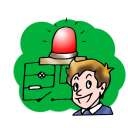By Laura G. Smith

|
The Nuts & Bolts of Light Bulbs
By Laura G. Smith |

|
 1 It's a convenience we use every day, usually several times a day. We walk into a room, flip on the switch, and presto - there is light!
1 It's a convenience we use every day, usually several times a day. We walk into a room, flip on the switch, and presto - there is light! |
Create Weekly Reading Books
Prepare for an entire week at once! |
| Leave your feedback on The Nuts & Bolts of Light Bulbs (use this link if you found an error in the story) |
 |
Electricity Worksheets | edHelper.com
|
 |
Science
|